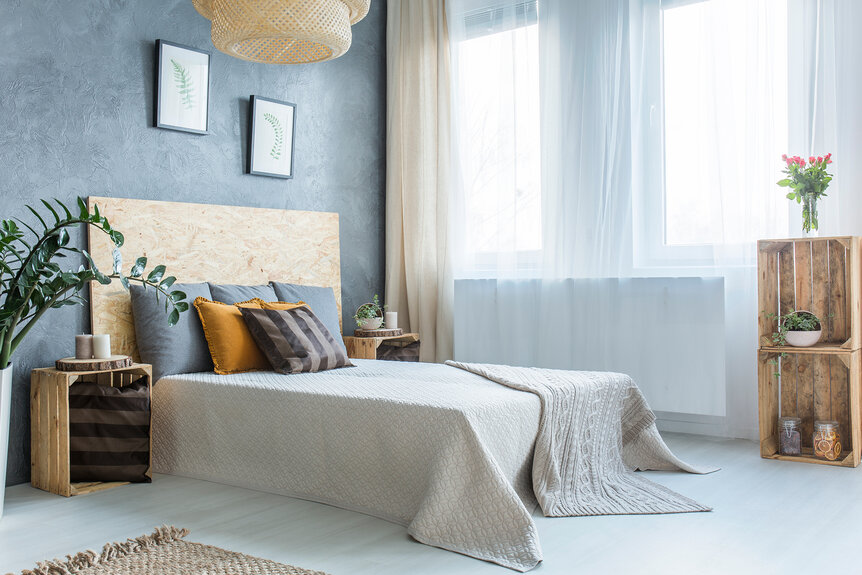
Create a free profile to get unlimited access to exclusive videos, sweepstakes, and more!
Having Trouble Sleeping? Your Bedroom Could Be the Problem...
Many people unknowingly sabotage themselves when it comes to bedroom hygiene and decor, turning their nighttime refuge into an insomniac's den.

Our bedrooms are meant to be a haven — a place where we can wind down for the evening before slipping under the covers and melting into sleep. The problem is that many people unknowingly sabotage themselves when it comes to bedroom hygiene and decor, thereby turning that “refuge” into an insomniac’s den.
Even if you don’t struggle with falling asleep, there are mistakes you might be guilty of that make sleep less fulfilling and, in general, the space way less inviting. Fret not. We spoke to several experts who highlighted exactly what you’re doing wrong and, more importantly, how to fix the problem.
You’ve Filled Your Bedroom with Media
We hate to pull out the mom card, but the only media in your bedroom ought to be books.
“The stimulation of the screen keeps you awake, which is not exactly conducive to a good night’s sleep. The blue light spectrum emitted from our screens has been found to suppress our natural melatonin,” explains Carolyn DiCarlo, a wellness-inspired architectural designer based in New York City. “Also, doing non-sleeping things in your bedroom can trigger your mind into screen mode when you should be in sleep mode. And yes, that means your TV, too.”
Move the TV to another room and let your phone charge away from the nightstand.
You’re Definitely Not Washing Your Sheets Enough
You’ll be hard pressed to find someone who washes their bed linens as often as they should: every two weeks. This may sound like too often, but we assure you it's not. You wash your favorite shirt every time you wear it, so why not your bedding twice a month (at minimum)?
Overnight, your body sweats and sheds dead skin cells, which turns your sheets into a veritable theme park for microscopic dust mites. Sleeping in unwashed bedding is terrible for your skin — it’s a primary culprit for body and facial acne — and it’s terrible for your breathing. To make the process easier, have two sets of bedding on hand and wash the dirty bedding at your leisure versus stripping the bed and waiting around for the dryer to finish its cycle.
That Lumpy Old Bed is Killing Your Zzz Vibe
What’s even worse for your sleep, believe it or not, is sleeping on a mattress that’s not comfortable. Sure, it was a splendid purchase when you bought it — a decade ago — but it’s now lumpy, saggy, and filled with years’ worth of dried sweat and skin cells. The average “lifespan” of a bed is 10 years, so if yours is creeping up on that time frame, or if your back is out of whack every morning, it’s time to invest again. (Check out our 13 favorite mattresses here.)
“Even missing one good night's sleep can weaken your immune system, affect your mood, and potentially affect your work performance and brain function,” notes Joe Alexander, the founder and CEO of Nest Bedding, which specializes in making affordable, luxury mattresses that are organic and natural (and yes, the beds are insanely comfy). “Getting into a ‘sleep rhythm’ is important. Going to bed at the same time, unplugging from electronics, not eating right before bed, and relaxing your mind [are] all important factors in getting to sleep and getting good sleep.”
Signs of poor sleep include waking up feeling tired, tossing and turning throughout the night, moodiness, weight gain, and — indirectly — increased caffeine consumption.
Note that your pillows also need to be replaced regularly — about every six months for inexpensive polyester and every one to two years for memory foam.
Clutter Has Slowly Taken Over
“It’s so much better to err on the side of minimal when it comes to a bedroom,” advises DiCarly. “The less stuff you have in front of you, the less cluttered your mind, and the more that you can open up your imagination and feel a mental spaciousness that one might associate with the outdoors.”
An easy way you can cut down on clutter, in addition to donating a truckload of unnecessary trinkets to Goodwill, is by having designated storage spaces. Maybe it’s a bookcase, or maybe it’s piece of furniture that doubles as hideaway storage, such as Kvell’s Nordik Storage Lounge Chair or Ottoman.
Plus, take five minutes out of your day to tidy your bedroom, which includes cleaning your nightstand, picking up laundry, and discarding trash.
Lighting and Noise Are Working Against Your Interests
It’s important to make your room peaceful in terms of both sound and light. If you live on a busy street with lots of noise pollution, DiCarly recommends incorporating a white noise machine into your space. You can also try one of the many apps available on your phone. If you’ve got the time and money, you could even hire a contractor to install a layer of sound-deadening sheetrock against your walls.
“If you are sensitive to light, then get blackout shades,” she advises. “When it’s daytime, let lots of light in by opening those curtains, and keep your windows clean for maximum sunlight.”
Your Fancy Down Comforter Isn’t Doing You Any Favors
“The number one biggest mistake I see is down and feather comforters. Hear of the old expression ‘water off a duck's back?’ That's because feathers are waterproof,” says Alexander. “A down and feather comforter traps heat and doesn't wick away moisture that builds up in our sleep, causing discomfort and leading to sleeping hot and sweaty.”
His suggestion is to replace it with a wool-filled comforter or cotton quilt. Another sweat-inducing culprit is microfiber sheets, which are technically plastic. Like down and feathers, the material doesn’t allow your body to wick away sweat and can leave you feeling sticky, hot, and uncomfortable all night long. When in doubt, opt for cotton.
The Color Scheme Is Waging a War Against Your Wellness
DiCarly tells us that color has a huge impact on your emotional state — so think soft, zen, comforting, or subtly sexy.
“Don’t use fire-engine reds — you’ll never sleep — or depressing or heavy colors. [For example], a strong purple paint color can stimulate the brain and wreak havoc on your restful sleep,” she advises. “In general think paler, softer colors with a hint of grey. Also, remember that the color on the tiny paint swatch gets intensified tremendously when the area colored is 1000 times the size, so keep the color soft and nurturing.”
Consider your bedroom a personal sanctuary that’s just steps away when you need it most. It’s a destination that allows you to recharge not just where sleep is concerned, but in terms of your mood, health, and general state of mind. It truly has potential to be a place where you can peel off the layers of stress from your day.
By heeding all the above advice, your space will be a reprieve you look forward to spending time in every day, and your sleep — and health — will improve as a result. (And seriously, wash your sheets, friends.)



























